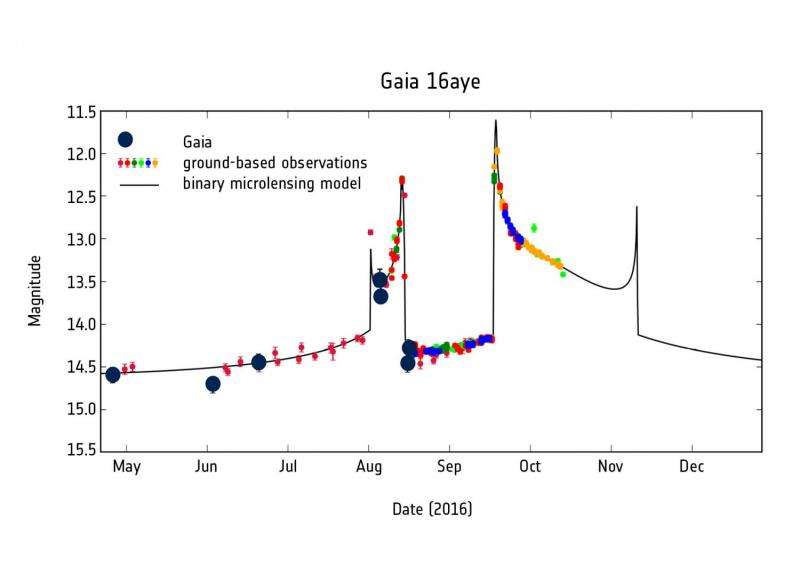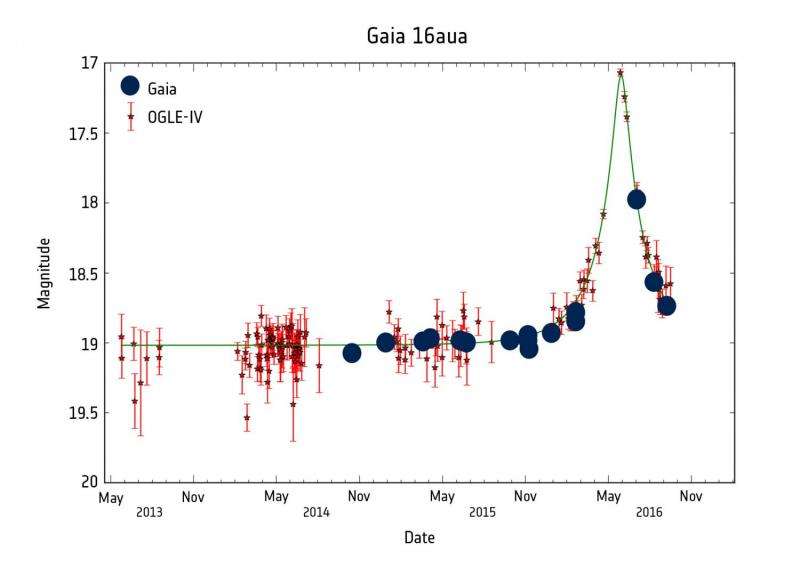Gaia spies two temporarily magnified stars

While scanning the sky to measure the position of over one billion stars in our Galaxy, ESA's Gaia satellite has detected two rare instances of stars whose light was temporarily boosted by other celestial objects passing across their lines of sight. One of these stars is expected to brighten again soon. Gaia's measurements will be instrumental to learn more about the nature of these 'cosmic magnifying glasses'.
The two events were identified in July and August 2016, respectively, by the Gaia Photometric Science Alerts Team, who scrutinise the Gaia data looking for astronomical sources that are, for a short period of time, much brighter than usual.
So far, the team has detected over a thousand transient sources, most of which are stars undergoing a major outburst, or supernova explosions at the end of a star's life. The discoveries are now routinely announced to the astronomical community, via the Gaia Photometric Science Alerts website, so that other astronomers can follow up, in a timely manner, with other telescopes.
On rare occasions, there is also another phenomenon that can produce a sudden boost in a star's brightness: the gravity of other celestial objects that happen to pass between the star and the observer.
According to Albert Einstein's general theory of relativity, gravity causes massive objects – like stars, planets, galaxies or black holes – to bend the fabric of spacetime. This also distorts the paths of light rays passing nearby.
When such a massive object is exactly aligned between a distant source of light and an observer, it acts as a gravitational lens, and the observer may see a dramatic increase (and subsequent decrease) of the source's brightness – much like when we observe something through a magnifying glass. This phenomenon is called gravitational microlensing.
"Microlensing of stars in our Galaxy is very useful to dig up objects that don't emit light, like black holes, but can still distort the light coming from background stars," explains Łukasz Wyrzykowski, from the Warsaw University Astronomical Observatory, Poland, and a member of the Gaia Photometric Science Alerts Team.
"Stars, multiple stellar systems and even planetary systems can act as gravitational lenses, each giving rise to a different pattern of variations to the brightness of the background star."
Gaia's first detection of such an event, classified as Gaia16aua and nicknamed by the team Auala, after a small village in Samoa, is a faint star of magnitude 19 that suddenly brightened by two magnitudes. The brightness rise and subsequent decrease were observed independently, both by Gaia and by the ground-based Optical Gravitational Lensing Experiment (OGLE). The ground-based observations provided a longer and denser baseline of data, confirming that the brightness variations observed by Gaia were actually caused by a microlensing event.
The effect of gravitational lensing depends on the mass of the lens – as well as on the relative distances between source, lens and observer. In the case of a nearly perfect alignment between source, lens and observer, the brightness of the background star increases and its position in the sky appears slightly shifted. By measuring both these tiny effects, it is possible to estimate the mass of the unseen object that is acting as a lens.
What makes it special to find microlensing events with Gaia, a mission whose scientific goal is to measure stellar positions in the sky to unprecedented accuracy, is that astronomers will be able to measure the motion of the source on the sky as its brightness varies due to gravitational lensing.
"By combining Gaia's information on the changes in position of the background star with ground-based data of its brightness variations, we will be able to estimate the mass of the object that bent its light with very good precision," explains Timo Prusti, Gaia Project Scientist at ESA.

"The lens in this case could be either a star or a black hole, and further analysis will tell."
Gaia's second microlensing event, classified as Gaia16aye and nicknamed Ayers Rock after the famous landmark in Australia, is perhaps even more intriguing. After the initial discovery by Gaia of an anomalous increase in the brightness of this magnitude 14.5 star last August, astronomers started observing it with many telescopes on the ground, revealing a rather peculiar pattern of brightness variations.
Instead of a single rise and fall, the star has undergone two consecutive brightness peaks of roughly two magnitudes, then became fainter for a few weeks. It later exhibited a sharp increase to magnitude 12 and rapidly declined again.
"This intricate pattern suggests that the star is not being lensed by a single object but rather by a binary system," says Przemek Mróz, a PhD student at Warsaw Astronomical Observatory.
The star's brightness is expected to undergo a final surge in the coming weeks, reaching around magnitude 12 for a few hours, and frequent observations are currently being carried out by professional and amateur astronomers across the world. Wyrzykowski and his colleagues are looking forward to more observers, including schools with small telescopes, joining the final phase of this monitoring campaign.
The full data set, along with Gaia's estimate of the star's position, will be instrumental to reveal the mass and nature of the foreground lens.
The astronomers think the culprit is most likely a binary system of stars, but it is also possible that a planet, or even a black hole, are part of the system.
Another peculiarity is that both lensed stars found by Gaia are located in the spiral arms of our Milky Way galaxy – something that is extremely rare.
"Microlensing happens for one in a million stars when we observe towards the Galactic Centre, but only about once in a hundred million for spiral arm stars," explains Wyrzykowski.
"We were extremely lucky to find these two events," adds Simon Hodgkin, head of the Gaia Photometric Science Alerts Team at the Institute of Astronomy in Cambridge, UK.
Over the past couple of decades, astronomers have been regularly observing microlensing of stars using telescopes on Earth, leading to many findings including the discovery of several exoplanets.
While ground-based surveys can only monitor individual patches of the sky, Gaia can now detect these events over the entire celestial sphere, and the combination of different data gathered from ground and space might reveal more information about the nature of these cosmic lenses.
After over two years of Gaia scientific operations, the Photometric Science Alerts Team have developed very efficient algorithms to detect transient events, and are planning to refine these further to improve the efficiency for microlensing detections.
Provided by European Space Agency




















